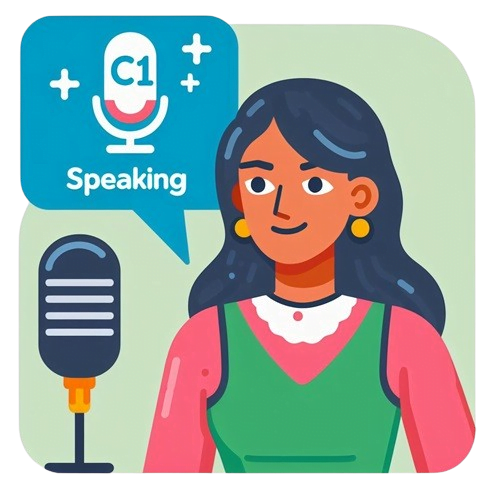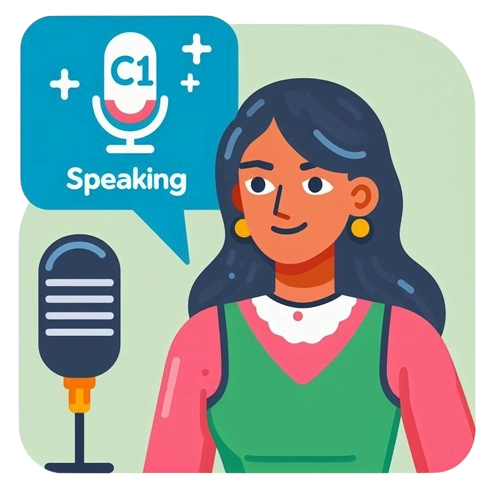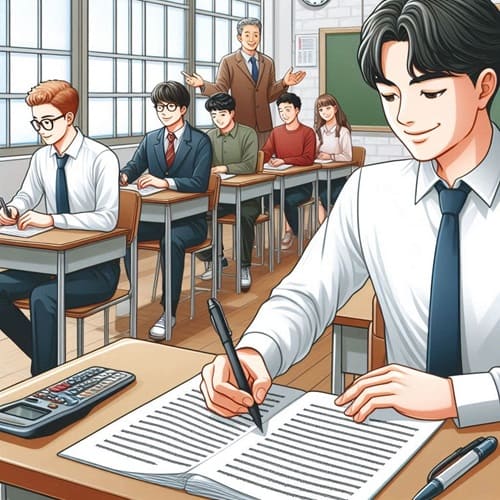Cambridge C1 (CAE): Guide to Speaking Part 2

Key Takeaways
To ace the Cambridge C1 Advanced (CAE) speaking part 2 make sure to do the following:
- Very quickly, choose two or three points about the pictures to address (similarities, differences, why(s), how(s), or the importance of the concept(s) shown in the pictures) before you start speaking.
- Make sure to make comparisons between the pictures (ideas) you are talking about. This is what you will be evaluated on.
What you will find in this guide:
Speaking Part 2
Unlike part 1 where you answer questions posed by the interlocutor, the C1 speaking part 2 involves speaking on your own, which is called the “long turn”. So, candidates are given the opportunity to speak for 1 minute without interruption. Each candidate is asked to compare two color photographs from a choice of three, and to make a further comment about them in response to a task that is read out by the interlocutor. A prompt is given to the candidates in the form of a direct question; this is written above the photographs.
Candidates are expected to point out similarities and differences between the photographs and then move on to deal with the question, answering it with reference to both photographs. Candidates have the opportunity to show their ability to organize their thoughts and ideas, and express themselves coherently in appropriate language. The candidate is also asked to listening to their partner and comment on it briefly (for about 30 seconds). They should not, however, speak during their partner’s long turn. Candidates will always be asked to speculate about something which relates to the focus of the visuals. They will never be asked to merely describe the visuals.
Sample Question
The video below is published by Cambridge as a sample speaking interview with real speaking question. It provides a clear example of what candidates can expect in the Cambridge C1 Advanced (CAE) Speaking Part 2. It includes a set of photographs and a prompt that guides the candidate on how to compare, contrast, and speculate about the images. This serves as a practical tool for candidates to practice framing their responses within the one-minute timeframe, ensuring they cover all necessary aspects of the task.
Examiners' Comments
Cambridge Examiners have provided detailed comments on this video and the performance of the people you see in this speaking test. This is an invaluable resource for understanding the expectations and common pitfalls encountered during the exam. By clicking on the provided link, candidates can access detailed feedback from actual examiners, which highlights the strengths and weaknesses of previous candidates’ performances. This feedback can help future exam takers to avoid common mistakes and focus on areas that can improve their scores.
The Rubric
The C1 Advanced Speaking Rubric is a downloadable document from Cambridge that outlines the specific criteria used to assess candidates’ performances in the Speaking Part 2 of the CAE exam. It details the parameters for fluency, coherence, language use, and other key competencies. Having access to the rubric allows candidates to self-assess and tailor their preparation to meet the exam’s rigorous standards.
Potential Challenges in Speaking Part 2
Since I have taught exam preparation for over a decade, I’ve seen that many candidates practice speaking in Cambridge C1 Advanced (CAE) and struggle with similar issues. So, I can confidently tell you that what potential challenges you may face in this part and help you overcome them. My goal is to share these common challenges with you and provide solutions to ensure these challenges no longer pose a problem for you.
So, let’s take a look at what those challenging factors may be in speaking part 2:
Explaining Pictures and Answering Questions Simultaneously: This task requires multitasking, which can be difficult for some candidates. They need to analyze the picture, formulate their thoughts, and express them clearly, all while responding to the examiner’s questions. This can be particularly challenging under time pressure.
Using Comparison: In the CAE speaking test, candidates often need to compare two pictures together. Under stress, it’s easy to forget this requirement and focus solely on describing each picture individually. However, making comparisons is crucial for demonstrating a higher level of language proficiency.
Going Beyond Describing the Picture: The CAE speaking test is not just about describing what’s in the picture. Candidates are expected to discuss the broader topic, speculate on the situations or emotions depicted, and express opinions. This requires a good command of language and the ability to think critically and creatively.
Unfamiliar Topics: The CAE speaking test can cover a wide range of topics, some of which may be unfamiliar to the candidates. This can make it difficult to express thoughts and opinions clearly and accurately.
Using the Right Words to Describe Unfamiliar Topics: When faced with unfamiliar topics, candidates might struggle to find the right words to express their thoughts. This can affect their fluency and coherence, which are key assessment criteria in the test.
Guide to Part 2
Part 2, long turn, tests candidate’s ability to produce an extended piece of discourse. Therefore, you must show that you are fluent, accurate, and have the ability to speak about a range of topics with minimal help. So, please do the following:
- Choose two pictures to talk about.
- Very quickly, choose two or three points about the picture to address (similarities, differences, why(s), how(s), or the importance of the concept(s) shown in the pictures) before you start speaking. This way, you can ensure you will have enough ideas to express and that you won’t finish prematurely.
- Make sure to make comparisons between the pictures (ideas) you are talking about. This is what you will be evaluated on.
- Use appropriate linkers and cohesive devices for your comparisons (as opposed to, similar to, etc.)
- Speak naturally at normal pace. Do not speak fast and make sure you are not speaking slowly. Sometimes, candidate get stressed out and speak faster or slower than they usually do as a result of their stress. Make sure this wouldn’t happen to you.
- Do not use memorized phrases. Rehearsed speeches should be avoided as these are easily spotted and they might be inappropriate for the questions asked.
- Don’t think about the pictures and do not pause to plan your answers while you are speaking. All the planning has to be done beforehand. ‘think on your feet’ and answer a question quickly, even if you have never thought about a particular subject before.
- Make sure that your response goes beyond the level of pure description and contain a speculative element. For example:
‘This picture shows two people who are on an expedition. They have to work together to achieve their goal.’
is not as impressive as:
‘These people look like they’re on an expedition to the North Pole or they might be climbing a mountain together. This could be a personal challenge, a kind of dream for them, or they might be doing it because they have work to do during the trip – like doing some research into animal life or the natural world, so they could be friends or they could be colleagues. Either way, their relationship must be very strong. Their lives could depend on how well they co-operate with each other if there is an emergency.’ - Make sure that your explanation of the pictures covers enough details and gives logical reasons for the points you are making. This means that if you are saying the person seems tired in the picture, you have to explain why you think he seems tired, and your explanation should be convincing. You cannot claim something without adequately supporting it with logical and convincing reasons.
- Try and use a variety of appropriate tenses, structures and vocabulary in this part of the test. This will create a good impression and give you confidence to tackle the other parts of the test.
- Make sure you are listening to your partner while he/she is speaking. You will be asked a question about the topic your partner is speaking about. So, make sure you will be ready to answer that question by listening to his/her response very carefully. try saying: Unlike David (your partner) I think the people in the picture don’t seen to be enjoying what they are doing because….. This way you can make sure your responses are relevant to the bigger context of the whole discussion.
Cambridge C1 (CAE) Speaking Part 2 Practice Test
Use this guide to practice speaking and enhance your speaking skills by practicing with the following topics. Each topic is designed to help you develop the ability to compare, contrast, and speculate effectively, as required in the Cambridge C1 Advanced (CAE) Speaking Part 2. By practicing these topics, you’ll become more comfortable organizing your thoughts, using varied vocabulary, and maintaining fluency and coherence under exam conditions. Here are some suggested topics to practice:
Isolated places
- How might the people be feeling?
- Why might they be in these situations?

People taking a break
- How might the people be feeling?
- How demanding might their activities be?

People and personalities
- What sort of personalities might they have?
- What might they do for a living?

Water
- What are the different ways in which water is being used?
- Why might water be important in the lives of these people?

Speaking Checklist
Use a checklist to track your performance. Download the checklist here and evaluate your speaking.
How was your experience?
I’m curious to know how you experience was reading about and practicing speaking part 2. So please describe your experience taking the part 2 speaking in the comment section below. Also, if you want to practice speaking part 3, you may want to check out my comprehensive guide to part 3 here.







For my point of view, this part is difficult because I have a few second to think my answer. Also, there are unfamiliar topics. Finally, I have one minute to answer the question and give a short description of the picture and concept.
In my opinion about second part of speaking is difficult because I feel nervous and my mind confuses the grammar structure that I need to use and I don’t notice immediately.
Ana Marcatoma
I would like to say that it is difficult to do as we need to be well-prepared to develop the activity. Also, in this second part, you have short time to think about what you want to say and to be able to build such a good speech to demostrate a C1 level.
By Angelica Muzha
For me in this speaking part the organization of the ideas is the most difficult. It is because despite we have to share the content we also have to answer two questions. Also, when the topics are unfamiliar I struggle with the speaking.
From my point of view this part is one of the most difficult of the exam because there a lot of images that represent different situations and for us is difficult to have specific vocabulary for each one.